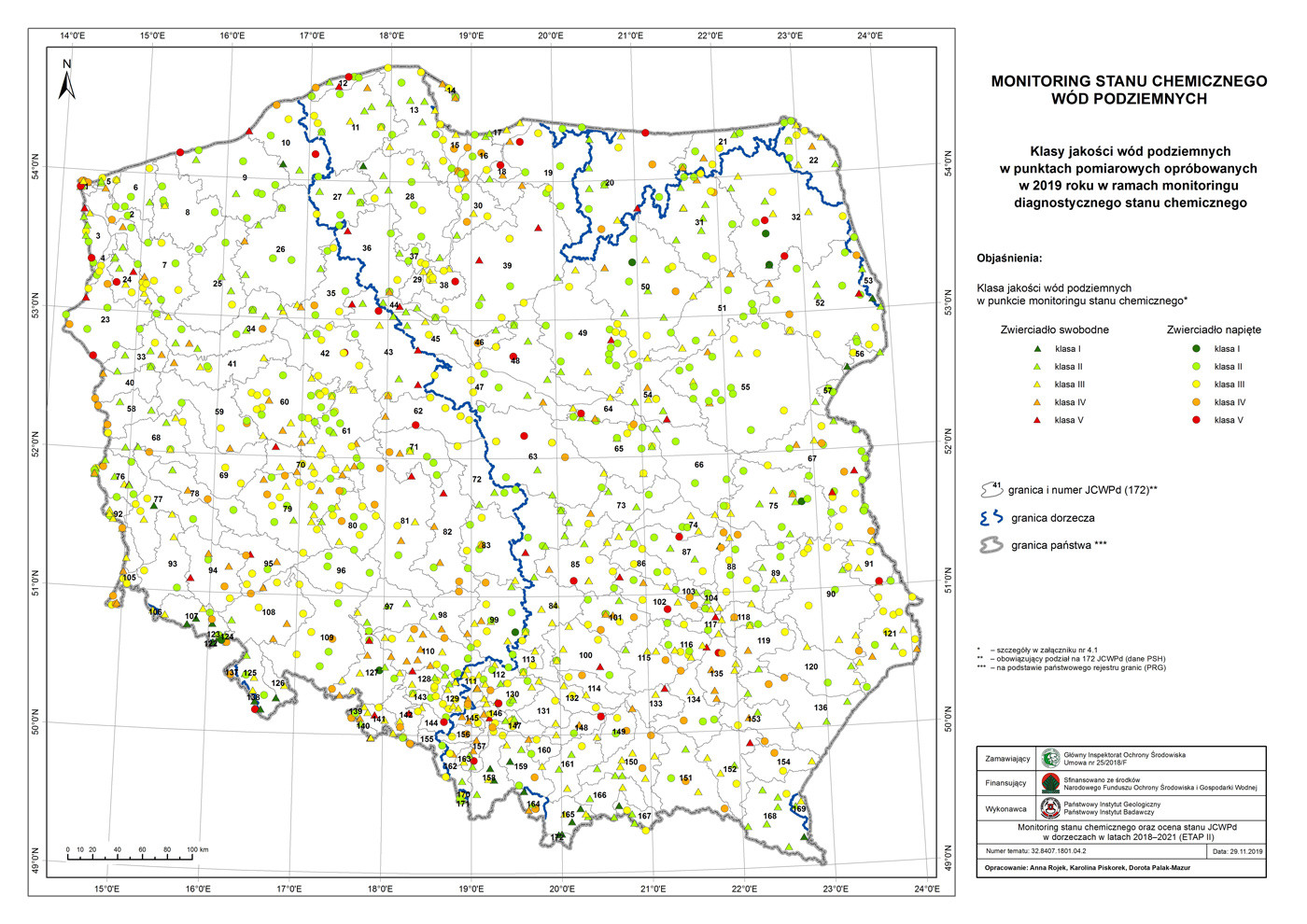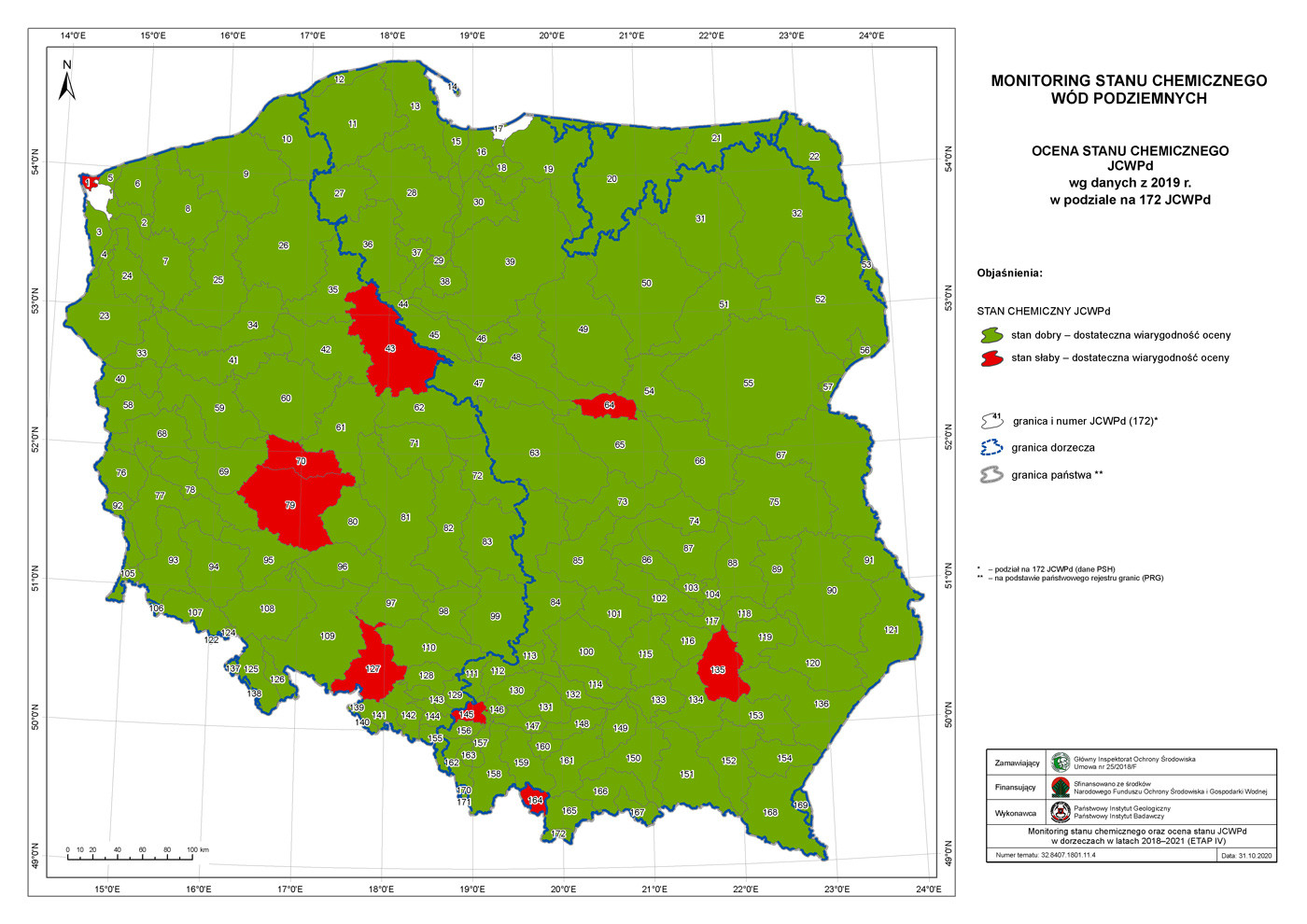The Polish Geological Survey - WL deals with analysis of pressures and impacts on groundwaters in chemical and quantitative terms and assessment of groundwater state within the area of groundwater bodies.
Groundwater chemical state monitoring
The key element of implementation of water policy in the country is continuous monitoring, analysis and assessment of the state of groundwaters by the member states in order to protect and gradually improve water resources in Poland and Europe. In order to fulfil the aforementioned requirements on groundwater quality, the Water Framework Directive imposed a groundwater chemical state monitoring obligation, with the detailed goal, scope and frequency established in the Regulation of the Minister for the Environment of 19 July 2016 on forms and methods of monitoring of groundwater bodies and surface waters (Journal of Laws of 2016, item 1178).
In accordance with that regulation, three types of groundwater chemical state monitoring are distinguished, namely surveillance, operational and investigative. Each type of monitoring involves different goals, namely:
- Surveillance monitoring of groundwater bodies is carried out in order to supplement and verify the procedures of assessment of the natural and anthropogenic influences, as well as assessment of significant and sustained upward trends in the concentration of pollution caused by natural and anthropogenic influences. Surveillance monitoring of groundwater chemical state is carried out at least once within a 6-year cycle of the catchment management plan update. It is meant to provide a general assessment of the water state within the territory of the country. The most recent surveillance monitoring was conducted in 2019.
- Operational monitoring of groundwater bodies is carried out in order to assess the chemical state of groundwater bodies considered to be at risk of not meeting their designated environmental criteria, as well as to detect significant and sustained upward trends in the concentration of pollution caused by anthropogenic influence. In accordance with the provisions of the Regulation of the Minister for the Environment on groundwater and surface water bodies (Journal of Laws of 2016 item 1178), it shall be carried out at least once a year, excluding years when surveillance monitoring of groundwater chemical state is conducted. Operational monitoring was carried out in 2013, 2014 and 2015, 2017 and 2018.
- Investigative monitoring of groundwater bodies is carried out in a manner which helps to explain the causes of failure to meet the environmental requirements of each groundwater body, identify the range and concentration of pollution, if a groundwater body was inadvertently contaminated, and identify the range of significant decrease of groundwater levels, which poses a risk of not meeting designated environmental criteria by a given groundwater body. The scope and frequency of investigative monitoring of groundwater bodies is adjusted to the causes of its execution and local conditions, so that the results provide information on necessary actions be taken in order to achieve designated environmental criteria or on specific preventive measures to counteract the consequences of inadvertent contamination. Investigative monitoring can be set to a single groundwater body or its fragment in order to discover the cause of not meeting its designated environmental criteria, which is not possible to explain on the basis of data and information acquired by the means of measurements and studies carried out within the scope of surveillance and operational monitoring. Investigative monitoring is also performed in the case of inadvertent contamination of a groundwater body in order to identify the spatial range and concentration of contamination.
In terms of the manner of groundwater quality classification, the European requirements on groundwater state assessment were transposed to national legislation through the Regulation of the Minister for the Environment of 21 December 2015 on criteria and manner of assessment of groundwater state (Journal of Laws of 2016, item 85).
General information about the network
Research within the framework of chemical state monitoring is conducted in the measuring network of about 1,200 points (including bored wells, piezometers), meeting the criteria of the Water Framework Directive. The network is subject to review and expansion with new points selected out of existing hydrogeological boreholes (with particular inclusion of active drinking water intakes) and newly established measuring points.
A majority of the measuring points involve shallow aquifers mostly located within Quaternary aquifers, which is the most commonly distributed aquifer in the country, while other measuring points involve deeper aquifers in older hydrogeological structures.
Over 70% of measuring points of the monitoring are hydrogeological stations within the groundwater monitoring network, managed by the Polish Geological Institute – National Research Institute within the framework of implementation of the Polish Hydrogeological Survey’s tasks. Owners of the other measuring points are municipal waste companies and municipalities (concerning drinking water intakes), private companies and individuals.
The results of physio-chemical indicators in samples collected from measuring points are a basic source of data used for the purpose of designation of groundwater quality classes and assessment of the chemical state of groundwater bodies.
All source data are verified for the proper execution of chemical analysis, by the means of analysis error calculation with an ionic balance. Only samples with analysis errors of less than 10% are approved for further studies.
Groundwater chemical state assessment
Groundwater chemical state assessment is carried out annually and involves analysis of the results of operational and surveillance monitoring. It performed every three years and conducted parallel to an assessment of chemical state assessment in accordance with data from surveillance monitoring. The aforementioned assessment is the basis for reports on groundwater state prepared for national and international institutions.
Figure 1. Classification within groundwater monitoring network points and chemical state assessment of groundwater bodies based on data from 2019.



